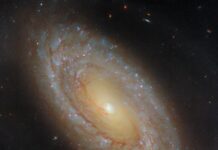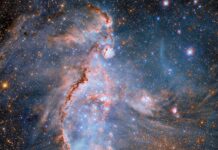Unveiling the Mysteries of Uranus: Insights from the Hubble Space Telescope
Uranus, often dubbed the "ice giant" of our solar system, presents a unique enigma to astronomers due to its unusual tilt and distant orbit. Unlike other planets, Uranus spins on its side as it makes its lengthy journey around the Sun. Now, thanks to an extensive study utilizing NASA’s Hubble Space Telescope, researchers have unearthed new revelations regarding its atmospheric composition and behavior. This groundbreaking study, which spans two decades, was made possible by Hubble’s exceptional capabilities in high-resolution imagery and spectral analysis, along with its enduring presence in space.
Understanding Uranus’ Atmospheric Dynamics
This long-term research offers astronomers invaluable data about how Uranus’ atmosphere operates and reacts to varying sunlight. Such insights not only enhance our grasp of Uranus itself but also provide a comparative framework for studying exoplanets that share similar characteristics in size and composition.
Back in 1986, NASA’s Voyager 2 spacecraft provided the first close-up glimpse of Uranus, revealing a seemingly featureless, blue-green orb. Fast forward to the present, and Hubble has chronicled a more dynamic and evolving narrative of Uranus’ seasonal changes from 2002 to 2022. Led by Erich Karkoschka from the University of Arizona, and Larry Sromovsky and Pat Fry from the University of Wisconsin, the team utilized Hubble’s Space Telescope Imaging Spectrograph (STIS) to offer a detailed portrayal of Uranus’ atmospheric structure.
Composition and Observations
The atmosphere of Uranus is primarily composed of hydrogen and helium, with a notable presence of methane, alongside traces of water and ammonia. The methane is particularly significant as it imparts Uranus its characteristic cyan hue by absorbing red wavelengths of sunlight.
Over the 20-year observation period, the research team utilized Hubble to observe Uranus on four separate occasions: in 2002, 2012, 2015, and 2022. Contrary to the gas giants Saturn and Jupiter, where methane is more evenly distributed, the team discovered that methane on Uranus is significantly depleted near its poles. This pattern remained largely unchanged throughout the two decades. However, the structure of aerosols and atmospheric haze experienced dramatic shifts, particularly brightening in the northern polar region as the planet moves toward its northern summer solstice anticipated in 2030.
Visualizing Uranus Through Hubble’s Lens
To visualize these changes, Hubble’s observations are displayed in a series of images that capture Uranus’ appearance across different wavelengths. These images reveal how the planet looks in visible light—what one might see through a powerful amateur telescope—and in false-color images, where visible and near-infrared light is used to highlight atmospheric components like methane and aerosols.
In the false-color images, green areas indicate regions with less methane, while blue areas have more. Red areas, particularly noticeable at the planet’s edge, indicate regions where the stratosphere is devoid of methane. This intricate mapping of Uranus’ atmosphere was not possible until Hubble’s STIS began its observations in 2002.
Changes Over Time
Throughout the study period, the team observed that at middle and lower latitudes, the distribution of aerosols and methane remained relatively stable. However, in the polar regions, these elements behaved quite differently. Notably, near the north pole, aerosols exhibited a dramatic increase, appearing very dark during the early northern spring and becoming significantly brighter in recent years. This suggests that solar radiation plays a pivotal role in altering the aerosol haze within Uranus’ atmosphere. Conversely, methane depletion maintained high levels in both polar regions throughout the observations.
Looking Ahead
As Uranus approaches its northern summer, astronomers will continue to monitor these atmospheric changes. This ongoing research not only enhances our comprehension of Uranus but also paves the way for understanding other distant, icy planets beyond our solar system.
The Role of Hubble in Astrophysical Discoveries
The Hubble Space Telescope, operational for over 30 years, continues to be an indispensable tool in the field of astrophysics, driving discoveries that reshape our fundamental understanding of the universe. A collaborative project between NASA and the European Space Agency (ESA), Hubble is meticulously managed by NASA’s Goddard Space Flight Center in Greenbelt, Maryland. Lockheed Martin Space, located in Denver, supports mission operations, while the Space Telescope Science Institute in Baltimore, operated by the Association of Universities for Research in Astronomy, handles Hubble’s scientific operations for NASA.
As we continue to delve into the mysteries of our universe, the insights gained from Hubble’s observations of Uranus serve as a testament to the power of sustained scientific inquiry and international collaboration in advancing our knowledge of the cosmos. For more detailed information, one can refer to NASA’s dedicated Hubble page at NASA Hubble Mission.
For more Information, Refer to this article.






















![Samsung’s Innovation Sparks Progress in Science and Industry: Quantum Dots How Samsung’s Engineering Feat Became a Catalyst for Scientific and Industry Advancement [Interview on Real Quantum Dots Part 2.]](https://www.hawkdive.com/media/samsung-tvs-and-displays-samsung-quantum-dots-technology-qled-tvs-quantum-dots-experts-interview-par-218x150.jpeg)











